Top 10 Inspiring Food Delivery App UI/UX Design Examples for 2025
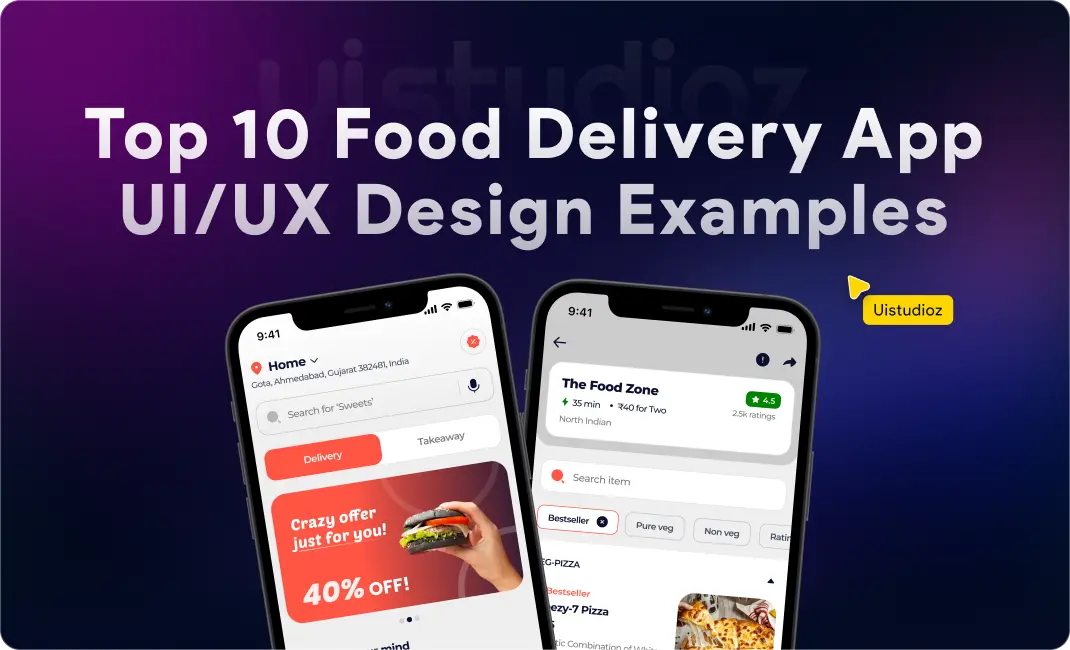
The food delivery landscape is more competitive and dynamic than ever before. With countless apps vying for user attention, the true differentiator lies in exceptional UI/UX design.
In this crowded marketplace, apps that fail to prioritize intuitive design and user-centric experiences quickly lose customers to competitors who understand that great design isn’t just about looking good; it’s about solving real problems and creating delightful moments throughout the ordering journey.
Think about it: The food delivery market is booming in 2025! Did you know the online food delivery market in India alone is a staggering USD 72.12 billion in 2024 and is projected to grow to USD 352.72 billion by 2034? That’s incredible growth, and with global revenue projected to reach $1.41 trillion by year-end and user penetration expected to hit 30.6%, the stakes are higher than ever.
So, how do the best of the best do it? How do they create apps that we genuinely love to open? Let’s deep dive into the top 10 most inspiring food delivery app UI/UX design examples for 2025, offering deep insights, actionable takeaways, and a forward-looking lens on what makes these platforms stand out.
10 Best Inspiring Food Delivery App UI/UX Design Examples for 2025
As a designer who’s navigated countless food ordering experiences, I’ve observed firsthand how leading apps differentiate themselves through their meticulous attention to UI and thoughtful orchestration of UX. Here are some of the prime examples setting the bar high for 2025:
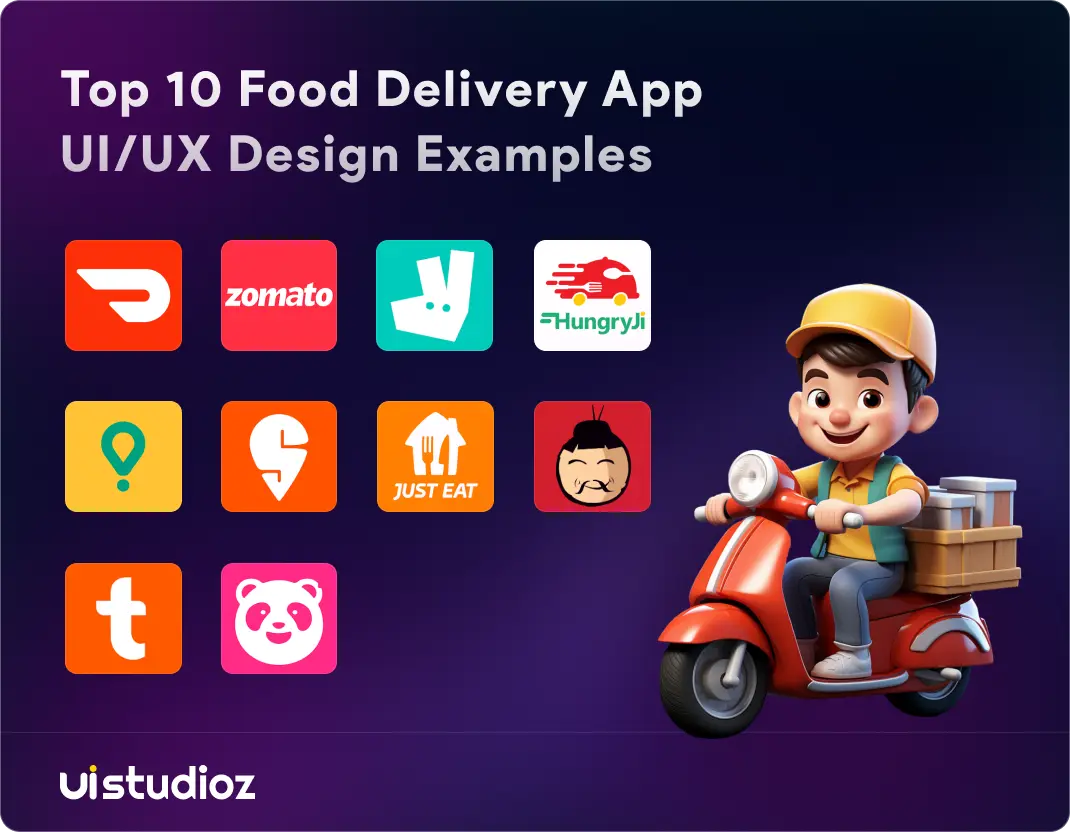
1. DoorDash (USA)
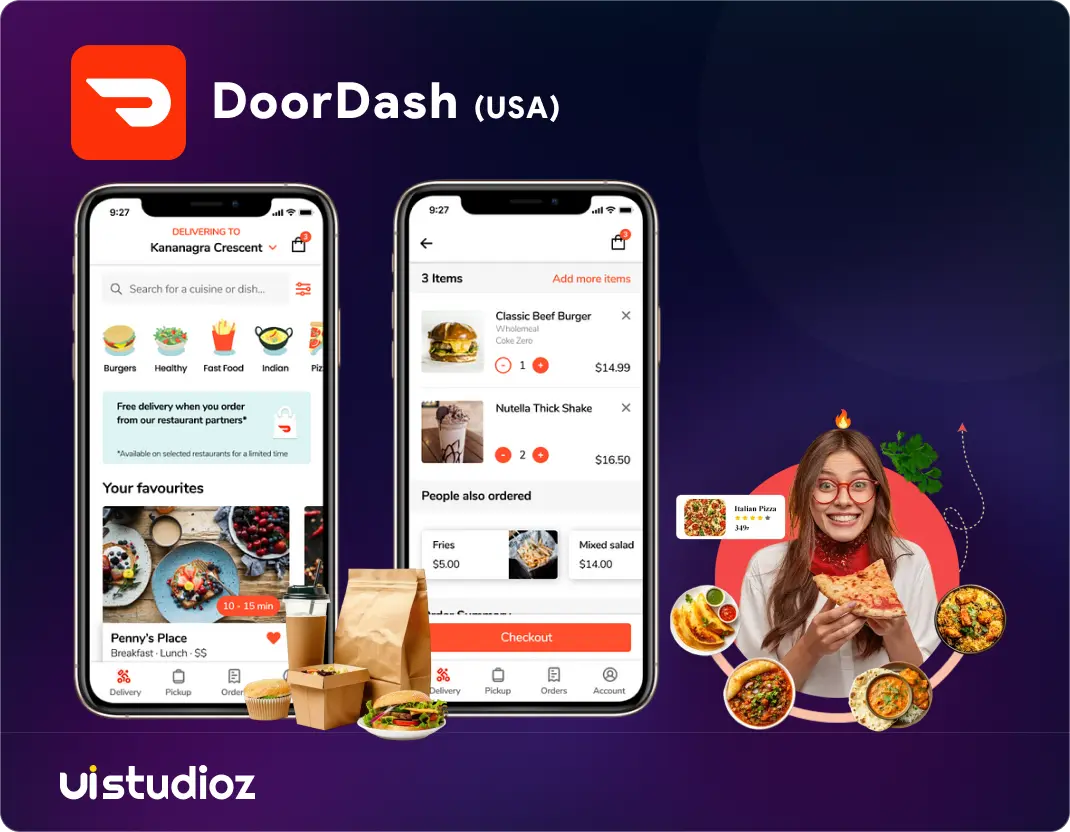
As a dominant force in North America, DoorDash focuses on a localized and efficient delivery network.
What Makes Its UI Great
DoorDash has mastered the art of visual hierarchy and clean design. Their interface uses a carefully balanced red-and-white colour scheme that creates energy without overwhelming users. The typography is clean and readable, strategically using bold weights to guide attention to key actions.
The app’s iconography is intuitive and consistent, using universally understood symbols that require no learning curve. The bottom navigation is clearly labelled with icons and text, eliminating any ambiguity about app sections.
What Makes Its UX Exceptional
DoorDash’s UX prioritises efficient discovery and delivery. Its “DashPass” subscription model integrates seamlessly into the user journey, offering clear benefits. The app provides highly accurate delivery time estimates and reliable real-time tracking. Their rating and review system is prominent, guiding user choices effectively. The focus on hyper-local delivery and a robust network of dashers ensures quick service and a key UX differentiator.
Key Takeaways for Designers:
- Prioritise speed over complexity—every additional step in the ordering process increases abandonment rates
- Use visual cues to communicate value—clear indicators for deals, delivery fees, and estimated times reduce user anxiety
2. Zomato (India)
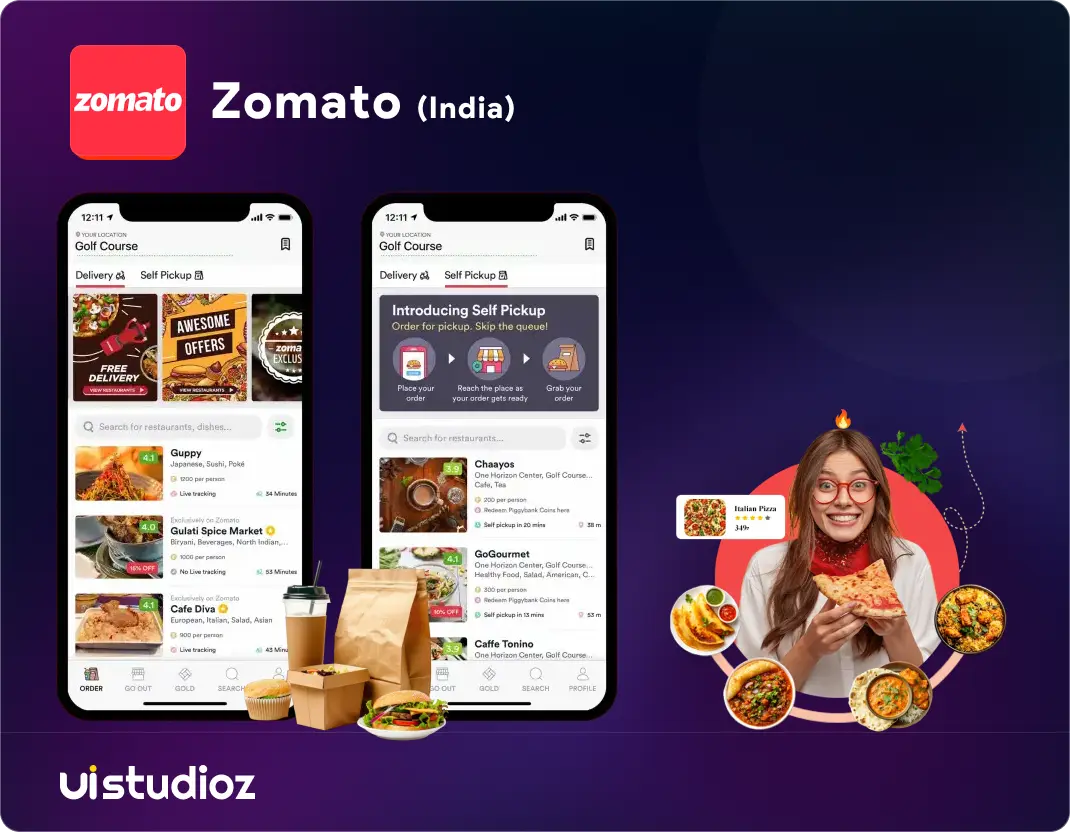
Zomato has established itself as a formidable player, especially in the Indian market, by consistently refining its user experience.
What Makes Its UI Great
Zomato’s vibrant red branding creates immediate recognition and appetite appeal. The interface uses playful illustrations and animations that inject personality into the typically utilitarian food ordering process. Their typography choices balance readability with brand character, using custom fonts that feel both professional and approachable.
The app’s content-rich approach successfully balances restaurant information, user reviews, and ordering functionality, avoiding information overload. Restaurant pages include comprehensive details, menu photos, user ratings, review highlights, and delivery information—organised in a scannable hierarchy.
What Makes Its UX Exceptional
Zomato’s social features integration creates a community around food discovery. User reviews, photos, and ratings seamlessly integrate into the ordering process, helping users make informed decisions. The app’s recommendation engine considers both personal preferences and social signals to suggest restaurants that are relevant to the user.
Their multi-language support is exceptional, with localised content beyond translation to include culturally relevant features and payment methods. The checkout process is optimised for different regions, supporting local payment preferences and delivery customs.
Key Takeaways for Designers:
- Social proof reduces decision anxiety—user reviews and ratings build confidence in ordering decisions
- Localisation goes beyond language—consider cultural preferences in design and functionality
3. Deliveroo (UK & Europe)
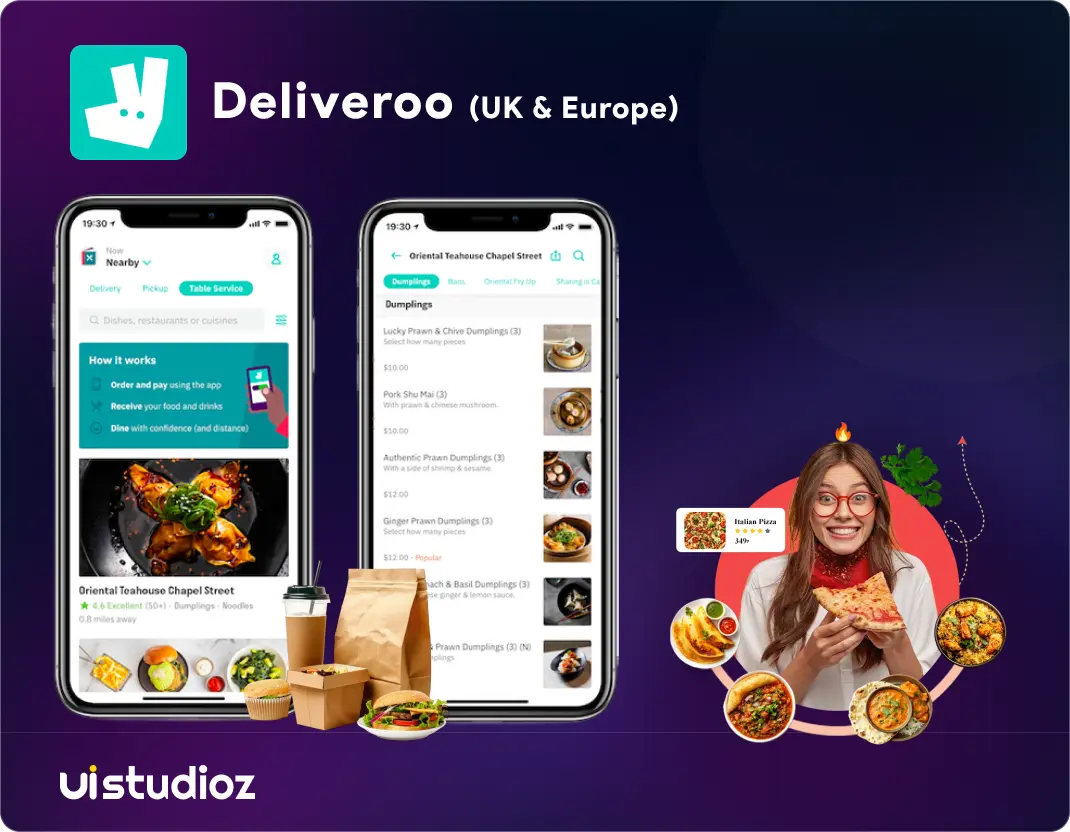
Deliveroo is known for its focus on premium restaurant partnerships and efficient delivery.
What Makes Its UI Great:
Deliveroo’s distinctive teal and white colour palette creates a premium, sophisticated visual identity that differentiates it from competitors. Their minimalist design philosophy emphasises clean lines and generous white space, creating an upscale dining experience that appeals to their target demographic.
The app’s high photography standards, consistent styling, and lighting make food appear more appetising. Restaurant cards feature elegant typography and subtle shadows that create depth without visual clutter. The interface uses subtle animations that enhance usability without being distracting.
What Makes Its UX Exceptional:
Deliveroo excels in premium user experience design with smooth transitions, intuitive gesture controls, and sophisticated micro-interactions. The app’s delivery tracking system provides detailed progress updates, beautiful map visualisations, and real-time courier information.
Their dietary filter system is comprehensive yet easy to navigate, with clear visual indicators for vegetarian, vegan, gluten-free, and other nutritional requirements. The checkout process is streamlined with one-click reordering and intelligent address detection.
Key Takeaways for Designers:
- Premium design justifies premium pricing, and sophisticated visuals can support higher-value positioning
- Dietary filters should be prominent—health-conscious users rely heavily on filtering capabilities
4. Hungryji (India)
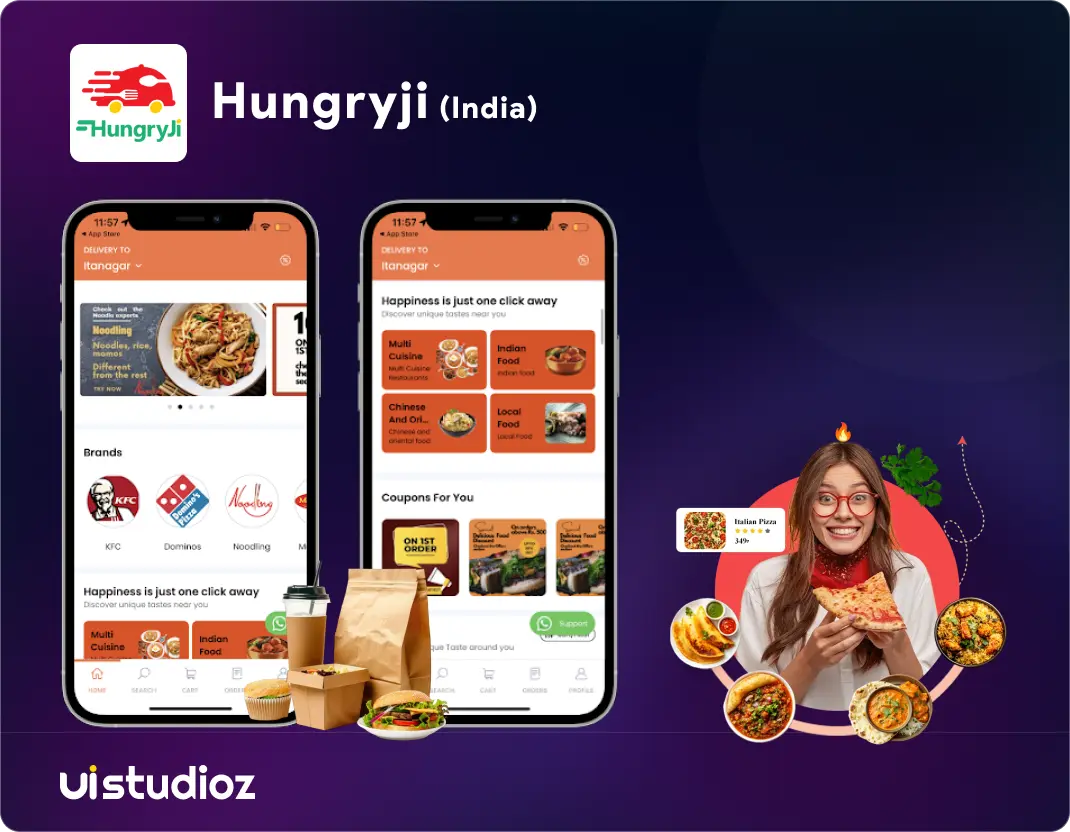
A rising player in the Indian market, Hungryji emphasises local culinary experiences and user-friendly navigation.
What Makes Its UI Great:
Hungryji employs a bold, colourful design approach that reflects the vibrancy of Indian cuisine. Their interface strategically uses warm oranges and reds to create appetite appeal while maintaining readability. The typography system successfully balances English and Hindi text, carefully focusing on regional script readability.
The app’s local flavour integration is evident in custom illustrations and cultural references that resonate with Indian users. Restaurant cards prominently display cuisine type indicators and spice level ratings, addressing specific local preferences.
What Makes Its UX Exceptional:
Hungryji excels in hyperlocal personalisation, adapting recommendations based on regional food preferences and local festivals. The app’s payment integration supports multiple Indian payment methods, including UPI, digital wallets, and cash on delivery, with clear visual indicators.
Their order customisation system allows detailed dish modifications, accommodating the Indian preference for personalised spice levels and ingredient adjustments. The customer support system includes regional language support for better user assistance.
Key Takeaways for Designers:
- Cultural relevance builds user connection—local design elements create emotional resonance
- Payment method diversity is crucial—support for regional payment preferences reduces friction
5. Glovo (Europe, Africa, Latin America)
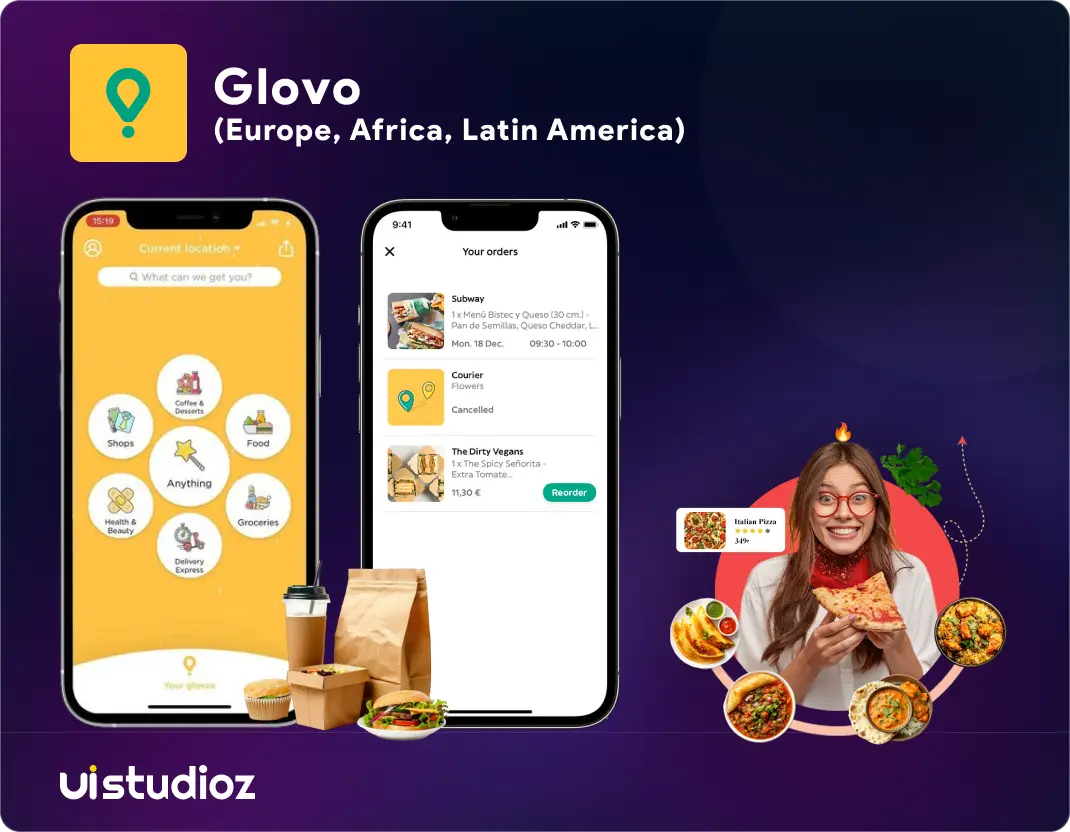
A prominent global player, Glovo distinguishes itself by offering “anything” delivery, not just food.
What Makes Its UI Great:
Glovo’s minimalist design approach creates a clean, uncluttered interface across diverse global markets. Their distinctive yellow accent colour is used strategically to highlight key actions and build brand recognition. The iconography system is universally understood, using simple symbols that transcend language barriers.
The app’s map-centric design prominently features location-based browsing, recognising that proximity is a key factor in food delivery decisions. Restaurant cards display essential information such as delivery time, ratings, and key details, without overwhelming users with excessive data.
What Makes Its UX Exceptional:
Glovo excels in multi-category integration, seamlessly blending restaurant delivery with grocery shopping, pharmacy orders, and other services. The navigation system separates different service types while maintaining consistent interaction patterns across global markets.
Their delivery tracking system provides real-time updates, accurate time estimates, and courier communication features. The app handles multiple currencies and payment methods smoothly, adapting to local market preferences.
Key Takeaways for Designers:
- Simplicity scales globally—clean interfaces work well across different cultures and service types
- Location-based features should be prominent—proximity significantly influences user decisions
6. Swiggy (India)
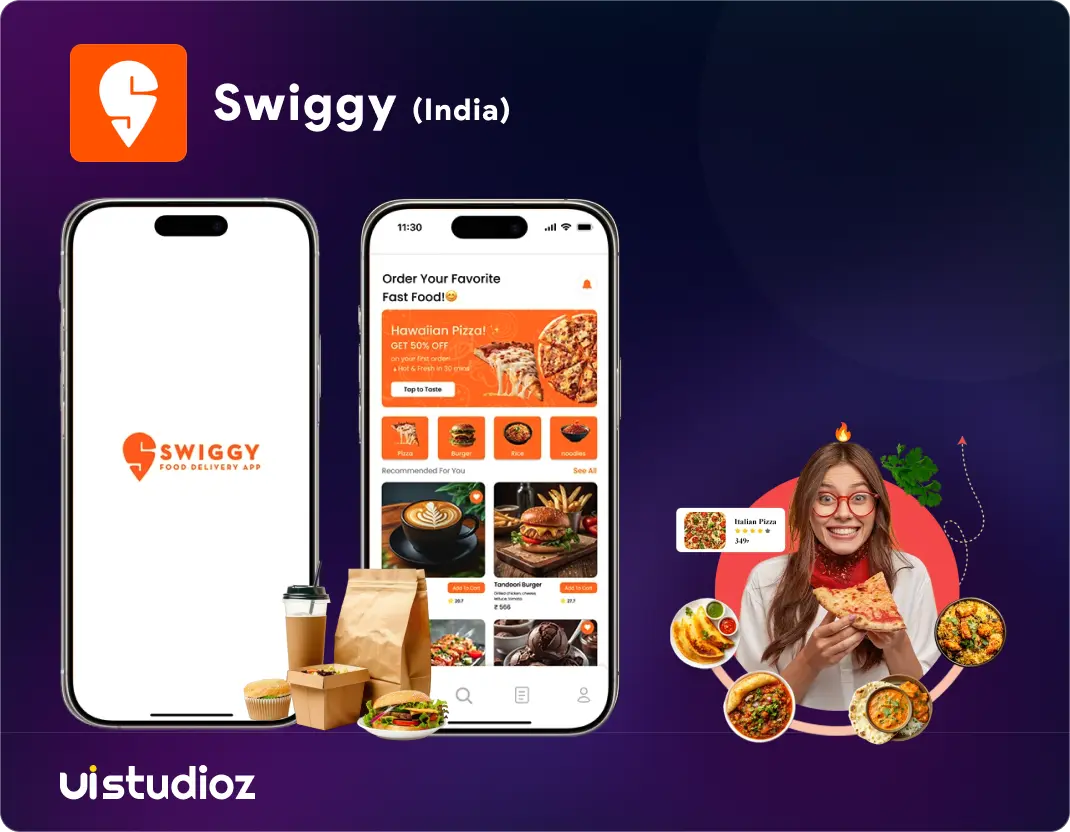
Swiggy, another Indian giant, stands out for its efficiency and extensive service offerings.
What Makes Its UI Great:
Swiggy’s orange and white colour scheme creates a vibrant, appetising interface that stands out in the competitive Indian market. Their typography system seamlessly balances English and regional language support, carefully examining readability across different scripts and character sets.
The app’s sophisticated promotional content integration features deals and offers prominently without creating visual clutter. Restaurant cards include localised information like preparation time and delivery distance, addressing specific user concerns in the Indian market.
What Makes Its UX Exceptional:
Swiggy excels in payment method diversity, supporting various options, including digital wallets and cash on delivery, with clear visual indicators for each. The app’s customer support system is deeply integrated, with chat support, order issue reporting, and FAQ systems accessible throughout the user journey.
Their loyalty program integration rewards frequent users with clear progress indicators and redemption options that feel valuable rather than gimmicky. The voice search feature accommodates users who prefer speaking dish names in local languages.
Key Takeaways for Designers:
- Localisation requires deep market understanding—payment methods and features should reflect local preferences
- Platform expansion should maintain core user experience—additional services should feel integrated, not tacked on
7. Just Eat Takeaway.com (Europe, Australia, North America)
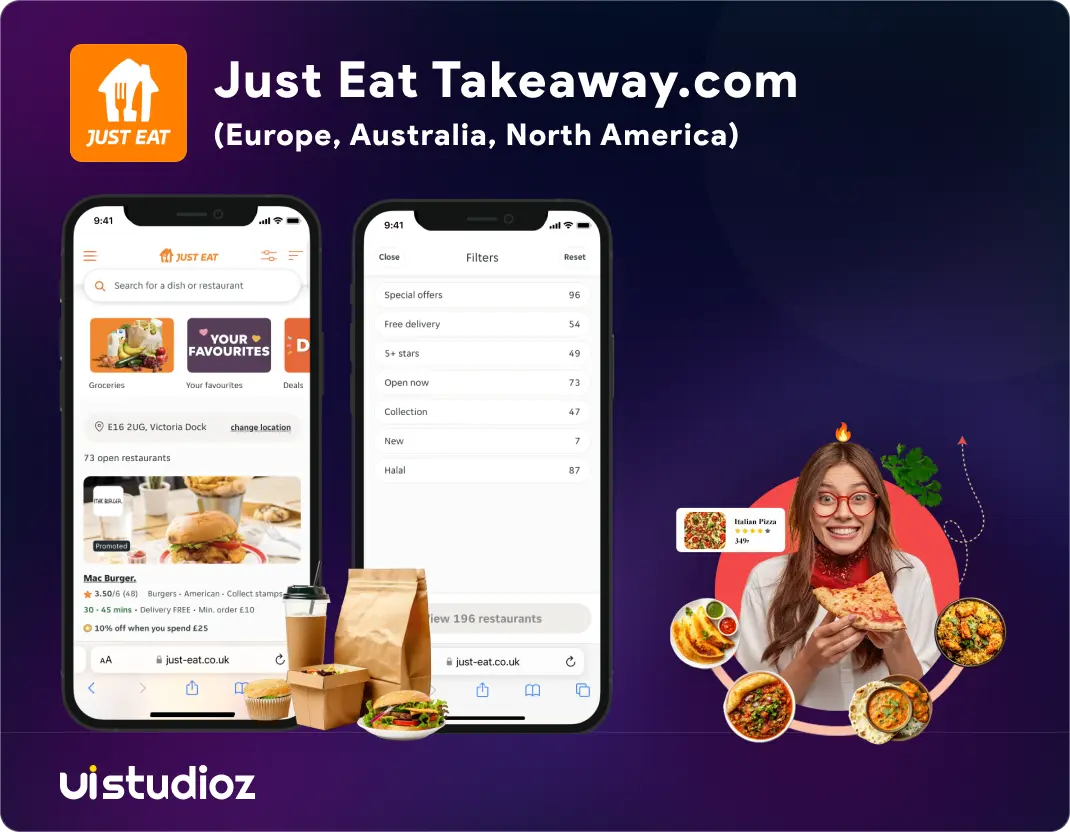
A global powerhouse, Just Eat Takeaway.com focuses on broad restaurant coverage and ease of ordering.
What Makes Its UI Great:
Just Eat’s orange and white branding creates a friendly, approachable interface that feels familiar and trustworthy. Their design system maintains consistency across multiple brands and regions, allowing local customisation. The typography is clean and readable, strategically using bold weights to highlight key information.
The app’s restaurant discovery features are comprehensive, with excellent filtering options and clear category organisation. Restaurant listings include extensive information about delivery fees, minimum orders, and estimated delivery times, reducing user uncertainty.
What Makes Its UX Exceptional:
Just Eat excels in cross-market consistency while accommodating local preferences. The app’s order tracking system provides clear status updates with estimated delivery times that adjust based on real-time conditions. Their reorder functionality is exceptionally smooth, making it easy for users to repeat previous orders.
The checkout process is streamlined with clear cost breakdowns and multiple payment options. Customer support is easily accessible with clear escalation paths for order issues.
Key Takeaways for Designers:
- Consistency builds trust—familiar interactions reduce user anxiety across different markets
- Transparency reduces friction—transparent pricing and timing information improve user confidence
8. Chowman (India)
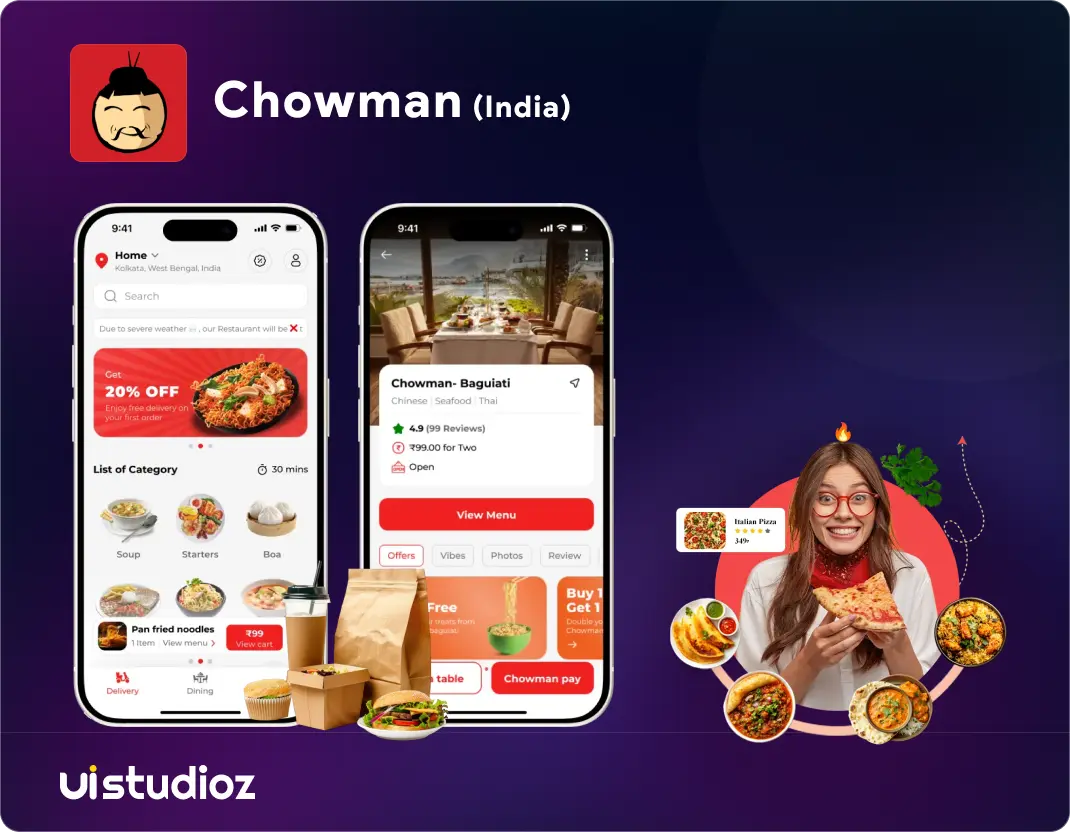
Chowman, a popular chain, has developed an app that mirrors its specialised culinary focus.
What Makes Its UI Great:
Chowman’s warm, inviting colour palette reflects the nature of their offerings: comfort food. The interface uses rich browns and appetising oranges, creating a cosy, homestyle feeling. Their typography choices balance readability with personality, using modern and approachable fonts.
The app’s food photography standards are exceptional, with consistent styling that makes dishes appear homemade yet professional. Menu layouts are clean and scannable, with precise categorisation and pricing information.
What Makes Its UX Exceptional:
Chowman excels in personalised recommendations based on user preferences and order history. The app’s customisation options allow detailed modifications to dishes, accommodating the Indian preference for personalised spice levels and ingredient adjustments.
Their order tracking system provides detailed updates with estimated preparation and delivery times. The customer support system includes regional language support and quick resolution pathways for common issues.
Key Takeaways for Designers:
- Brand personality should reflect food style—visual identity should match the dining experience
- Customisation options build user loyalty—flexibility in orders increases satisfaction
9. Talabat (Middle East & North Africa)
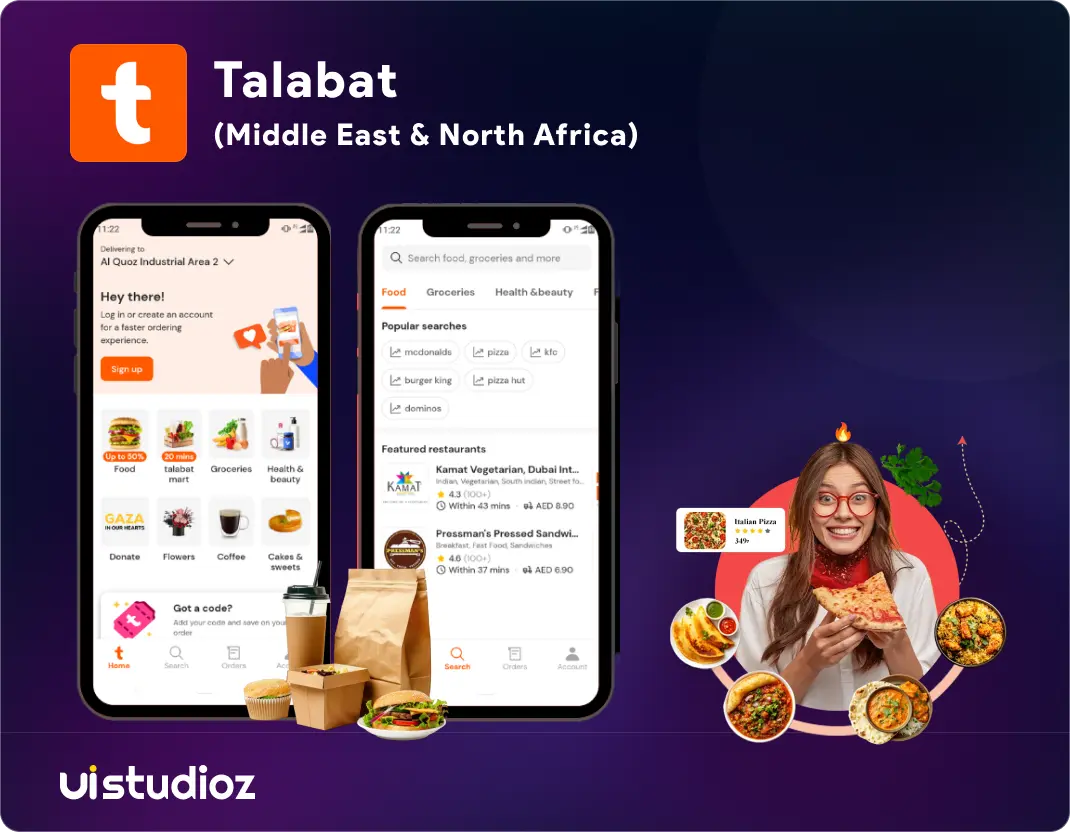
Talabat is a leading food delivery platform across the MENA region, known for its extensive reach and diverse offerings.
What Makes Its UI Great:
Talabat’s vibrant red and white design creates strong brand recognition across Middle Eastern markets. Their Arabic-English bilingual interface is seamlessly integrated, with proper right-to-left text flow and culturally appropriate design elements. The colour palette and typography choices reflect regional aesthetic preferences.
The app’s restaurant categorisation includes cuisine types popular in the Middle East, with clear visual indicators and filtering options.
What Makes Its UX Exceptional:
Talabat excels in cultural localisation, supporting local payment methods, currencies, and delivery preferences. The app’s timing features account for prayer times and cultural events, showing sensitivity to local customs.
Their family-sharing features allow multiple users to contribute to orders, reflecting the communal dining culture. The delivery tracking system provides accurate updates with local courier communication preferences.
Key Takeaways for Designers:
- Cultural sensitivity enhances user experience—understanding local customs improves app adoption
- Bilingual design requires careful planning—text expansion and reading patterns must be considered
10. Foodpanda (Asia & Europe)
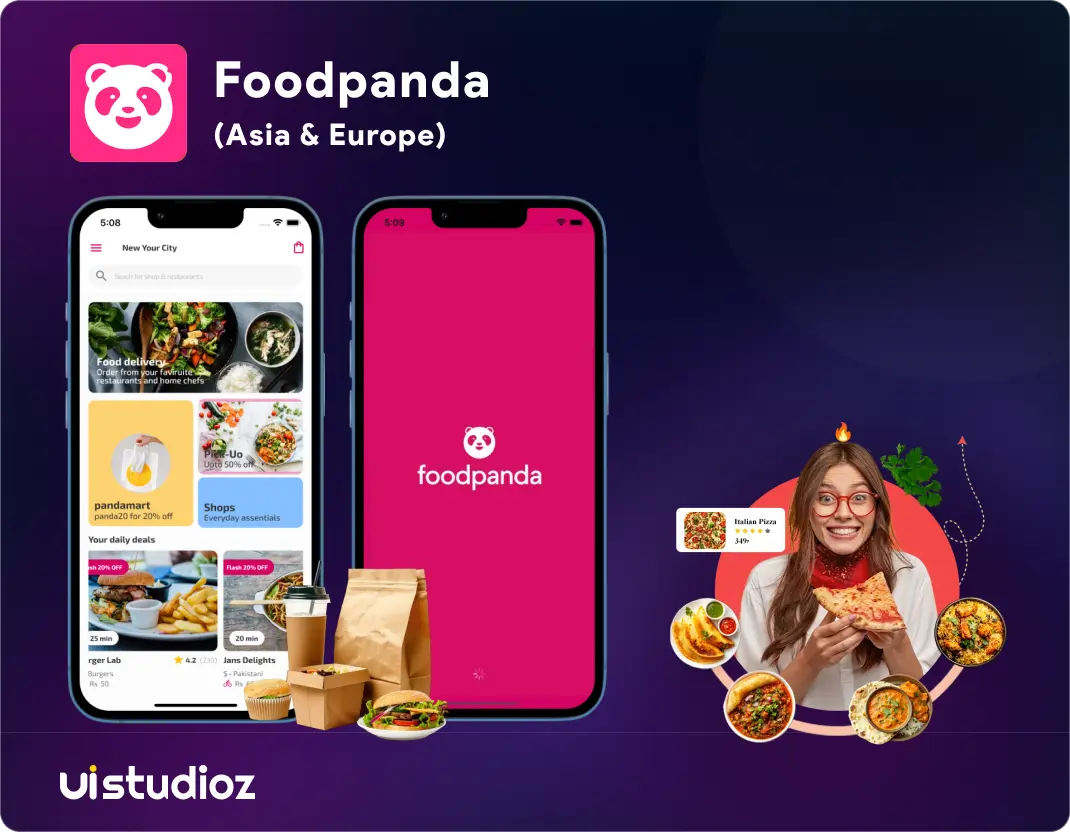
Foodpanda is a major player across Asia and Europe, recognised for its vibrant branding and extensive network.
What Makes Its UI Great:
Foodpanda’s distinctive pink and white branding creates instant recognition and differentiates it from competitors. Their playful design approach uses custom illustrations and animations that make food ordering feel fun and engaging. The typography is clean and modern, with strategic use of bold weights for emphasis.
The app’s global design system maintains consistency across multiple markets while allowing for local customisation.
What Makes Its UX Exceptional:
Foodpanda excels in multi-market adaptability, supporting different languages, currencies, and payment methods seamlessly. The app’s personalisation engine learns user preferences and provides relevant recommendations based on order history and browsing behaviour.
Their social features allow users to share favourite restaurants and dishes, creating a community around food discovery. The customer support system is comprehensive, with multiple contact methods and quick resolution processes.
Key Takeaways for Designers:
- Distinctive branding creates memorable experiences. A unique visual identity helps users remember and return to the app
- Global consistency with local adaptation—maintain brand identity while accommodating regional preferences
Key UI/UX Trends for Food Delivery Apps in 2025
As we move into 2025, several transformative trends are reshaping how users interact with food delivery apps. Understanding these trends is crucial for creating the best food app design for 2025 that resonates with modern users.
AI-Powered Hyper-Personalization
Artificial intelligence is revolutionising food delivery app experiences by creating truly personalised user journeys. Apps are now leveraging machine learning algorithms to analyse user behaviour patterns, dietary preferences, order history, and even weather conditions to provide tailored recommendations.
This goes beyond simple “based on your order history” suggestions. Advanced AI systems now predict what users want before they even know it themselves, surfacing relevant restaurants during lunch hours, suggesting comfort food on rainy days, or promoting healthy options when users are following fitness goals.
The key to successful AI personalisation lies in transparent customisation; users should understand why they’re seeing certain recommendations and have control over their personalisation settings.
Voice-First Interactions
Voice integration is becoming essential as users increasingly expect hands-free ordering capabilities. Smart voice assistants are being embedded directly into food delivery apps, allowing users to place orders, track deliveries, and get recommendations through natural language conversations.
The challenge for designers is creating voice interfaces that feel natural and intuitive while maintaining the visual richness that makes food discovery enjoyable.
Micro-Interactions and Haptic Feedback
Sophisticated micro-interactions are becoming standard for creating engaging experiences. These small animations and responses—like a satisfying “pop” when adding items to the cart or subtle vibrations when confirming orders—create emotional connections between users and apps.
Haptic feedback is particularly powerful in food delivery apps, where tactile responses can simulate the satisfaction of physical interactions with food, creating memorable moments throughout the ordering process.
Dark Mode Optimization
Dark mode has evolved beyond simple colour inversion to become a sophisticated design system that enhances food photography and reduces eye strain during late-night ordering sessions. The best implementations use carefully crafted dark themes that make food imagery pop while maintaining excellent readability.
Contextual Design Adaptation
Apps are becoming smarter about adapting to user context—automatically switching to simplified interfaces during busy periods, highlighting quick options for users in a hurry, or emphasising discovery features when users have more time to browse.
These trends aren’t just flashy add-ons; they solve real user problems, from decision fatigue to accessibility. Let’s see how top apps bring these to life with food app design examples for startups and established players alike.
Conclusion
The food delivery app landscape in 2025 is defined by an unparalleled focus on UI/UX, pushing the boundaries of convenience and innovation. The leading apps, including DoorDash, Zomato, Deliveroo, Hungryji, Glovo, Swiggy, Just Eat Takeaway.com, Chowman, Talabat, and Foodpanda, are thriving by deeply understanding user needs and creating genuinely delightful experiences.
If you’re a startup founder or product manager looking to revolutionise your food delivery app with expert UI/UX, or seeking a complete food delivery app solution to kickstart your venture, don’t hesitate to reach out. Let’s design the future of food together.